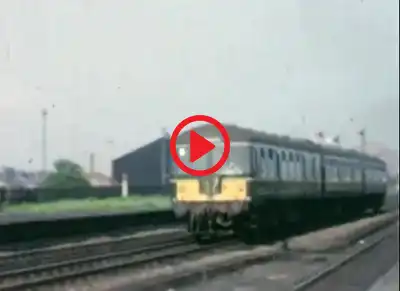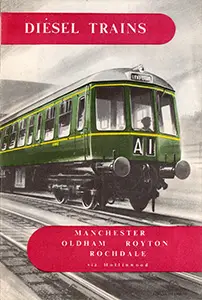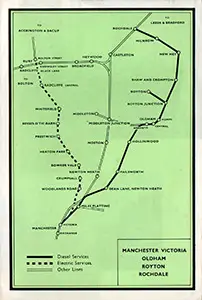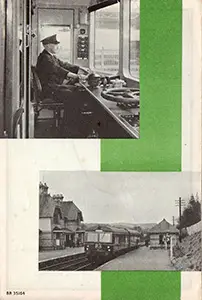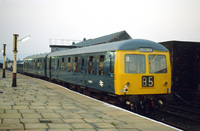Class 105/6 Cravens 2 & 3-car DMUs
Operations - Batch Two
LMR 3-cars - DMBSs 50752 - 70, TCLs 59307 - 25, DMCLs 50785 - 803
The nineteen three-car sets were delivered to various London Midland Region depots, all moved to Toton (18A) in April 1958 ready to enter traffic on the 14th April 1958 on the Lincoln - Nottingham (Midland) - Derby and Nottingham and Leicester lines of the LMR.
A folded leaflet was made available to the public promoting the new trains on the route:
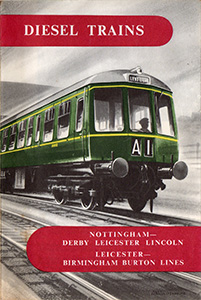
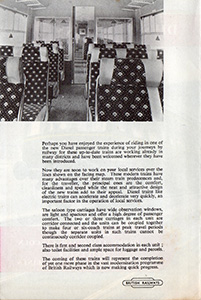
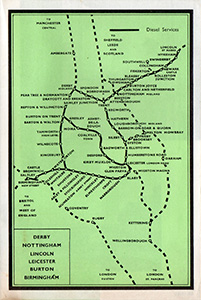
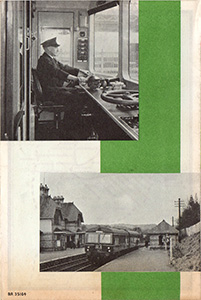
Running times between Nottingham and Lincoln was approx. one hour and 34 mins between Nottingham and Derby, 51 mins between Nottingham and Leicester (London Road), 66 mins between Leicester and Burton, and 79 mins Leicester to Birmingham. Many trains provided a through service between Lincoln and Derby. There were many more services than previously, and were generally run at hourly intervals. They were augmented by existing steam services at peak periods. Good connections were available between the Birmingham - Leicester and Leicester - Nottingham services and at Trent between the Leicester - Trent - Nottingham and Derby - Nottingham - Lincoln services. Sets were based at Nottingham & Leicester, although one stayed overnight at Saltley carriage sheds. Trains running between Leicester & Birmingham carried route indication B7 and those on the Birmingham - Derby line B8 & B9. Sets noted in Birmingham New St working these in the first few weeks were 105 triples 50754/59309/50787 to 50770/59325/50803.

The images shows M50798 at the front of the 5.25pm service to Derby waiting to leave Birmingham New Street on the first day of the new services, 18th April 1958. Michael Mensing.
The Birmingham - Leicester services were also worked by Class 104s, and on occasions 2-car sets were used such as 50392/56147 on the 30th May '58 with resultant overcrowding.
On Sun 1st June 1958 there was an 'Amateur Photographer' excursion from Nottingham, Mansfield and Derby, to Betws-y-Coed. It consisted of 9-cars, six from Nottingham (Midland): 50754/59809/50787 and a 3-car Class 104, and another 3-car Class 104 from Mansfield. The train left Derby (Midland) at 08:40, arriving Betws-y-Coed at 12:10. Departure was at 17:00, getting back to Derby seven minutes late due to a dead stand at Crewe.
On the Midland route to Manchester, the Co-Bos were frequently failing. on one such occasion one failed at Chorlton-cum-Hardy causing a 1½ hour delay to the 17:55 to St Pancras on the 15th October 1959. A relief train, consisting of a 3-car Cravens, was run in it's timing from Derby to St Pancras.
Axle Defects
In December 1961 the Midlands Cravens sets would be taken out of service for examination for possible axle defects. This had happened to the Hull sets a few months prior[1]. Services initially reverted to steam but DMUs were soon borrowed from other LMR depots - a 104 and 108s from Llandudno Junction, more 108s from Chester, and six 115 sets from Allerton/Marylebone. Most returned in February 1962, so presumably the Cravens issues were over by then.
The sets would be transferred from Toton to Derby Etches Park depot in December 1962.
In Spring 1966 four power-twins (50771-4 and 50804-7) arrived at Etches Park from Newton Heath and these would be found as part of the three-car sets.
Leaving their centre cars behind, four power cars (50756/60 + 50806/7) left Etches Park for Newton Heath in April 1968, another four (50764/71 + 50804/5) the following month.
One set (50774 + 59322 + 50799) was withdrawn as a result of the accident at Caholme Level Crossing in February 1969 when a Birmingham New Street - Derby service hit a tractor and trailer on the crossing.
The remaining Etches Park power cars, also formed into power twins, departed in May 1969 when a batch of Swindon Cross-Country sets arrived at Etches Park from the Western Region. They were transferred to the north west at Accrington, able to tackle the very hilly terrain north east of Manchester — their arrival allowed the withdrawal of the surviving Rolls-Royce engined Cravens power twins. They were joined by the eight power cars that moved from Etches Park to Newton Heath.
Centre cars withdrawn
For the 18 centre cars left behind at Etches Park, one (59307) was withdrawn in November 1968 and would be cut at Derby C&W Works in August 1969. In June 1969 fifteen were placed into store at Etches Park, the other two (59314/5) were reallocated to Newton Heath. Storage was short term — thirteen were withdrawn on 12 July and sold to John Cashmore Limited at Great Bridge (moving there from Chaddesden in October); the other two stored vehicles (59320/1) were withdrawn on 2 November and sold to TJ Thompson at Stockton. The two that moved to Newton Heath were withdrawn from there on 24/5/70 and sold to Arnott Young at Parkgate.
The centre cars survived just twelve years in traffic.
Accrington Closes
In October 1972 the power twins would move to Newton Heath when Accrington depot closed.

The image shows 50768 now working as a two-car set, having just worked the late afternoon through service from Windermere at Lancaster Castle on 2/8/79. Robert Frise
LMR power-twin sets - DMBSs 50771 - 84, DMCLs 50804 - 17
On Sunday 8th June 1958 50771/804 and 50773/806 operated a RCTS special 'The Roses Rail Tour', leaving Manchester Victoria and visiting various branches and MPDs, covering over 200 miles.
The power twin sets, allocated to Newton Heath, were introduced on the 9th June 1958 to services between Manchester (Victoria), Oldham (via Hollingwood) and Rochdale. The extra power was required for the 1 in 59/49 out of Victoria station, the long 1 in 50 to Oldham (Werneth), and one working over the 1 in 27 Middleton incline.
A folded leaflet was made available to the public promoting the new trains on the route:
Noted receiving attention in Horwich Works 10/5/59 were 50772/50805.
Four of the four power-twins (50771-4 and 50804-7) moved from Newton Heath to Etches Park from in Spring 1966 and these would then be found as part of the three-car sets.
Latterly many units were dispersed with some going to Norwich and others to Scotland at Hamilton and Haymarket. It was not uncommon for those remaining at Newton Heath to occasionally run with a trailer from another class.
All were withdrawn by 1983 except the "celebrity" vehicle 50812 which was paired with the remaining Class 100, by virtue of the fact it had it's asbestos removed.
References
- ⋏ Motive Power Miscellany, p136 February 1962 Modern Railways
Summary
Orders
Description - General
Description - Variations
Description - Interior
Works Photos & Drivers Inst.
Diagrams
Numbering
Liveries
Operations - Batch One
Operations - Batch Two
Operations - Batch Three
Operations - Batch Four
Operations - Scotland
Accidents
Decline
Parcel Use
Other Non-Passenger Use
Images
Details about preserved Class 105s can be found here.



